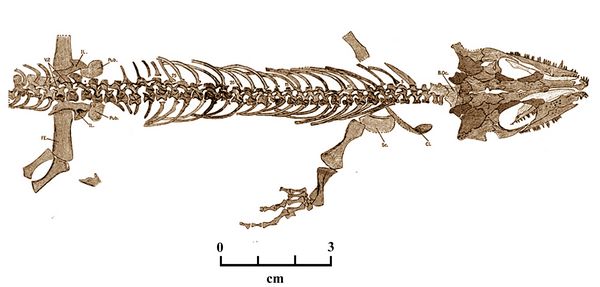Athena Review Image Archive ™
Gephyrostegus bohemicus

Gephyrostegus bohemicus (after Brough and Brough 1967, fig.10).
Gephyrostegus was a small reptiliomorph amphibian who lived in the Late Carboniferous (Pennsylvanian) period at about 310 mya. It was discovered in Nưřany in the Czech Republic, with the type species Gephyrostegus bohemicus represented by a skull and elements of the anterior postcranial skeleton (see fig.).
G. bohemicus belongs to the family Gephyrostegidae, together with the genus Bruktererpeton. Several phylogenetic studies indicate that Gephyrostegus is only distantly related to amniotes or early reptiles, more distantly than diadectomorphs, lepospondyls and seymouriamorphs.
The
adult was 22 cm in total length, one of the smallest known
advanced reptiliomorphs. It had a lizard-like build, with large eyes
suited to night hunting, and a large number of small, pointed teeth,
indicating it was an active insectivore.
Carroll (1970) reports that while the skeleton of Gephyrostegus
shows some adaptations for terrestrial life, it also retained
some traits characteristic to aquatic non-amniote tetrapods, such the
large size of the skull and the loose attachment of the vertebral
elements. Gephyrostegus spent a large proportion of its adult life on land, but probably retained the aquatic reproductive habits of amphibians.
References:
Brough, M.C. and Brough J. 1967. The Genus Gephyrostegus. Philosophical Transactions of the Royal Society of London. Series B, Biological Sciences no 252 (776): pp. 147–165.
Carroll, R.L. 1970. The ancestry of reptiles. Philosophical Transactions of the Royal Society of London. Series B, Biological Sciences. 257 (814): 267–308.
Copyright © 1996-2020 Rust Family Foundation (All Rights Reserved).